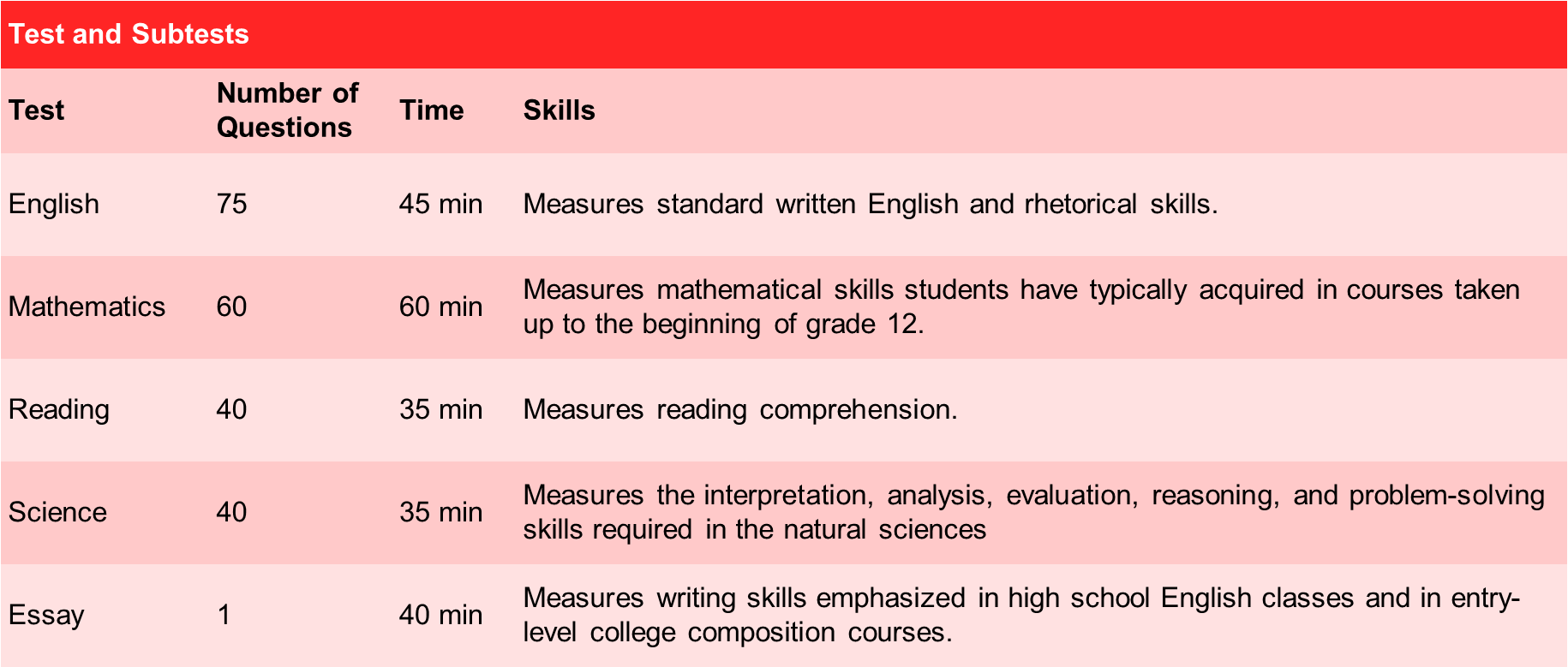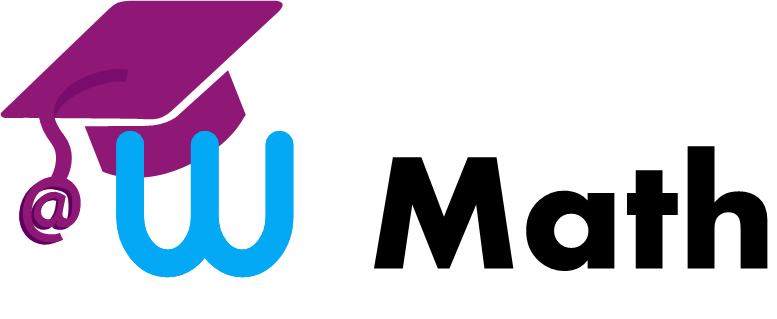In this post, we are going to breakdown the format of the ACT so you will know what to expect on the day of your exam.
The ACT has four sections – English, Math, Reading and Science. There is a fifth section which is optional, the Essay, and the requirement to complete it really depends on the school that you're applying to. You can save yourself 40 minutes by not doing it but it doesn’t hurt to do it. Overall the test is about two hours and 55 minutes long or three hours and 35 minutes with the Essay. The ACT is going to look a lot like the PSAT which you probably took as a freshman sophomore and or junior.

Each section is pretty straightforward. The English section has 75 questions in 45 minutes, so you have roughly about 40 seconds per question. The Math section has 60 questions in 60 minutes so about a minute per question. The Reading section has 40 questions and really four passages in 35 minutes, so you have roughly about seven minutes per passage.
And then you have the Science section which is a similar 40 questions in 35 minutes, comprising of about six to seven passages so about five to six minutes per passage. Last but not least is the Essay. Again, the Essay is optional and it doesn't really affect your composite score which is out of 36. To learn more about this you can follow the link below.
http://www.act.org/content/act/en/products-and-services/the-act/your-scores/understanding-your-scores.html

So now, let's talk about each section in detail starting with the English section. This section gets a bad rap because unlike the Math section, a lot of people think the answers are not very clear-cut. We are here to tell you that the English session is really easy to do if you get all the rules right! There are three subsections that are being tested; Production of Writing, Knowledge of Language and Conventions of Standard English.

These really break down to knowing your grammar rules, understanding what you read, and demonstrating how to form stylistically correct sentences or words within a sentence or paragraph. The English section is really comprised of five essays or passages with underlying portions that you have to correct. Here's an example of what you might see:

The passage will typically have a title (which we suggest you take note of) and have underlined portions like the above that you will have to correct (denoted by a number). To the side of this you'll see questions, for example, in Question 3 we're being asked to select a change to the portion underlined by a three.

After the English section comes the Math section. Don’t be intimidated by this section! After all, it only tests up to the beginning of your 12th grade, and unlike the SAT you are allowed to use a calculator for the entire section. We have summarized the subtests of the Math section for you in the table below.

The last subtest of the Math section is the least self-explanatory - Integrating Essential Skills. These are simply questions that test what you've learned all the way up to eighth grade. So that's going to include everything you learned from preschool up until high school.
The only other thing to note is that the ACT has recently emphasized modeling questions. Modeling questions are questions that ask you to convert real-world examples into mathematical functions and expressions. They compose about twenty-five percent of any of the questions in the subtests.
 The problem above would be a typical modeling question, we have a real world example of selling tickets and we're asked to find how many student tickets or social.
The problem above would be a typical modeling question, we have a real world example of selling tickets and we're asked to find how many student tickets or social.

The next section that you'll see on test day is the Reading section which is comprised of the subtests; Key Ideas and Details, Craft and Structure, and Integration of Knowledge and Ideas.

Key Ideas and Details just asks you questions about what you read, Craft and Structure asks you to interpret how what you read is written, and Integration of Knowledge and Ideas asks you to draw conclusions about what you read. That's the hardest section but it is also composed of the least amount of questions. There are four passages - two will be arts and literature passages, and two social science or natural science passages.

You'll always see a literary narrative or prose passage first, followed by a social studies passage which reads like something out of a newspaper. Then comes a humanities passage or arts passage; that has to do with art, music, literature or philosophy, and then last but not least, a natural science passage that reads like something out of Popular Mechanics or a science journal.

Above is an example of what would be asked. This would be the first passage that you see on test day as it is a literary narrative, which is just an adaption of the original story. You'll have ten questions for each of these passages that ask you about:
- Whether it's related to what you just read
- How it's written or;
- What conclusions you can draw from it
The ACT does have dual passages now, a lot like the SAT. A dual passage can be in any of these four categories - instead of one long passage there will be two shorter passages and there will always be two to three questions at the end that ask you to compare or contrast the two smaller passages.

Last but not least we have the Science section! You really shouldn't be intimidated by this section as it only asks basic concepts. If you paid attention in class and did reasonably well at it in school, you will be fine in the Science section. Think of it as a hybrid Math and Reading section because you're asked to do things that are related to Math like reading charts, diagrams and graphs, and most of the rest of it is just reading new concepts and applying them in a new setting.
The three kinds of questions you'll see are ones that ask you to:
- Interpret data
- Investigate a scientific experiment; where you'll be reading more than actually crunching numbers
- Evaluate models, so drawing conclusions from that data

The three kinds of passages you'll see are:
- Data Representation; two to three passages
- Research Summaries; two to three passages
- Conflicting Viewpoints; one passage only

The only thing to note here is that Data Representation sounds exactly like what it is - you're going to be asked to read data. Research Summaries ask you to interpret certain kinds of science experiments, and then Conflicting Viewpoints reads a lot like the Reading section just presented as a passage. There might be a chart presented in which case you're really just trying to assess multiple viewpoints; a lot like those dual passages described in the Reading section where you have to draw conclusions and compare and contrast opinions or fact.

Above is an example of that. It is a sample data representation problem which simply means it has a chart with data that you're asked to read. There will be between five to six questions per passage where you'll have to read the data and draw conclusions on it.
And that's about it for the sections that are actually graded on the ACT exam that form your composite score out of 36.


The last section is the optional Essay. We'll talk about this section in greater detail in another post, so keep your eyes peeled! Just to give you a preview you can think about how you would approach the following topic. In the example below, you would be asked to address the three perspectives given by drawing your own conclusion on which one you would support, and whether the other perspectives have strengths or weaknesses that support or detract from your own.

Happy studying!
